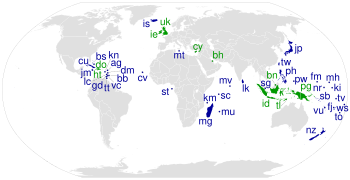
Countries/territories not shown on the map: Antarctica (aq) (continental disputed territory), Australia (au) (continental country), the Cook Islands (ck) (free association with New Zealand), Greenland (gl) (constituent country of the Kingdom of Denmark), Niue (nu) (free association with New Zealand), Northern Cyprus (ct.tr and nc.tr) (unrecognized country), and Puerto Rico (pr) (unincorporated U.S. territory).
This is a list of island countries. An island is a landmass (smaller than a continent) that is surrounded by water.[1] Many island countries are spread over an archipelago, as is the case with Indonesia, Japan, and the Philippines—these countries consist of thousands of islands. Others consist of a single island, such as Barbados, Dominica, and Nauru; a main island and some smaller islands, such as Cuba, Iceland, and Sri Lanka; a part of an island, such as Brunei, the Dominican Republic, East Timor, and the Republic of Ireland; or one main island but also sharing borders in other islands, such as the United Kingdom (Great Britain and a part of Ireland).
The list also includes two states in free association with New Zealand, the Cook Islands and Niue, as well as two states with limited diplomatic recognition which have de facto control over territories entirely on the islands, Northern Cyprus and Taiwan.[2] In total, 50 island countries have been included in the lists.
Australia is not included as it is considered a continental country, although it was historically referred to as an island country because of its lack of land borders.[3] Greenland is generally considered as the largest island on Earth and listed among the island territories. Puerto Rico in the Caribbean Sea is officially an unincorporated territory of the United States.
Indonesia is the world's largest island country by area (1,904,569 km2), and by total number of islands (17,504 islands).[4] It is also the world's most populous island country, with a population of over 270 million (the fourth most populous country in the world, after India, China, and the United States).
South America has only one independent sovereign island nation with Trinidad and Tobago; though considered a Caribbean island country, it is located on the northern portion of the South American continental shelf just 11 kilometres (6 nautical miles) off Venezuela, but 130 kilometres (70 nautical miles) from Grenada, the nearest of the Antilles.[n 1][5]
- ^ "Definition of island". Oxford University Press. Archived from the original on July 19, 2012.
- ^ The Republic of China (commonly known as "Taiwan") only controls the islands of Taiwan, Penghu, Kinmen, Matsu etc. after the Chinese Civil War, but has not renounced claim on areas currently under control of the People's Republic of China, Mongolia, Tuva (a Russian republic) etc. If those territories are taken into account, the Republic of China is not an island country or a country centered with a major island. The area under ROC control is also claimed by the People's Republic of China. See: One China and Political status of Taiwan.
- ^ Löffler, Ernst; A.J. Rose, Anneliese Löffler & Denis Warner (1983). Australia:Portrait of a Continent. Richmond, Victoria: Hutchinson Group. p. 17. ISBN 0-09-130460-1.
- ^ Which Countries Have The Most Islands?
- ^ Island Countries
Cite error: There are <ref group=n> tags on this page, but the references will not show without a {{reflist|group=n}} template (see the help page).